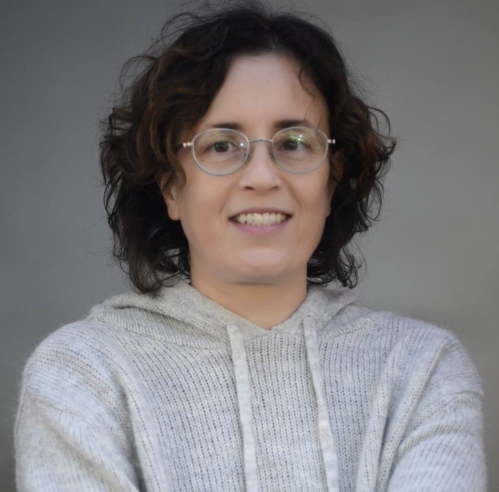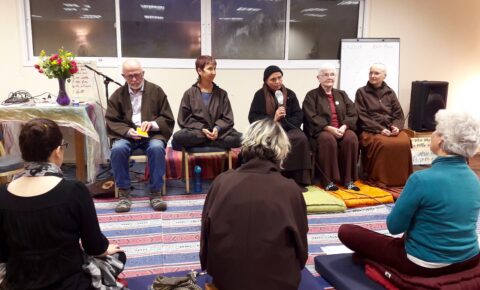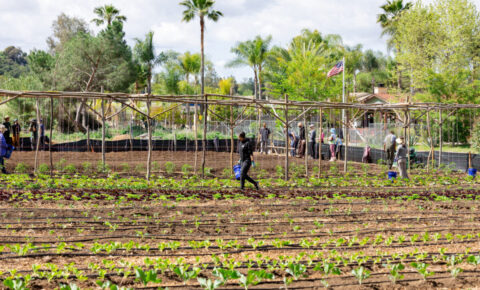As Hanukkah approaches, we have the opportunity to interview Plum Village lay Dharma teacher Hagit Harmon (formerly Sister Thai Nghiem), currently living in Tel-Aviv, Israel.

As a Plum Village practitioner with Jewish ancestry can you tell us how you practice what our teacher Thay calls “double belonging”. How does the Plum Village practice and your traditional Jewish roots blend together?
I didn’t grow up religious. So my main spiritual practice is from Plum Village, the Buddhist practice. I grew up in a kind of traditional way. You have written religion, but we were not really religious but also not secular. Some early stories from the Chassidic tradition (stories from Hasidic Judaism) go well with what I practice, I appreciate the depth of the Hebrew language, which is very ancient. Growing up with the stories of the Bible (the Old Testament) added a lot of richness. Of course, being here [in Israel], so I am very aware of all the holidays and the many Jewish holidays here which are usually spent with family. When I was in Plum Village, I noticed that certain times of the year would unconsciously bring up something [in me] related to the Jewish tradition. For example, the time before the Jewish New Year is a time of repentance and I noticed that happening in myself and I didn’t have to do anything. It just happened because it was alive in me. I was more aware of it in Plum Village than when I am here [in Israel] because here, there is a strong communal sense of things like that, so you don’t notice it, right? It’s when you’re away that you start to feel something and then you realize it has to do with the tradition you grew up in.
One thing that Plum Village has in common with the Jewish tradition is the Sabbath. The Plum Village lazy day is the Sabbath, yes? [laughs]. I really do see that at least a day a week of letting go is very important, not to get too caught up and serious about ourselves. I really take care not to communicate about work stuff on that day. So it’s not a religious thing for me but I don’t feel fully human if I don’t let go.

When you have challenges and difficulties how does the Plum Village practice or your Jewish roots help? What are some of your key anchors?
It’s important to recognize, what is the challenge? What is the nature of the challenge? Is it facing a difficult person where I probably need more support from others? Or is it a kind of internal struggle?
When I really feel flooded, sometimes touching the Earth while invoking the Bodhisattva names and their qualities helps me. It helps because it connects me to something wider than me so I can be in touch with both my Buddhist ancestors and Jewish ancestors.
The Plum Village tradition emphasizes taking refuge in the Sangha, so I feel that reaching out and getting support is helpful. Other times my challenges are such that I need to reconnect with nature.
In Israel there are religious people who are now discovering mindfulness or different kinds of therapy. It can be refreshing in a way, see your original tradition from a larger perspective and even from a more spiritual perspective sometimes.
One story from the Jewish tradition is very helpful for me, to remind me not to be too hard on myself. There was this very famous Russian rabbi, and when he was a child, he was already recognized as a very spiritual person and he used to go off into the forest. They kept going to look for him to bring him back as he was still small.
They asked him,” Why do you go there?”
“I’m going to meet God.”
“But God is everywhere, God is the same everywhere, why do you need to go there?”
He replied, “Yes, but I’m not the same everywhere. That’s why I need to go to the forest.”
From this, I remember that I am also not the same everywhere, I am very influenced by my environment, we’re connected. So that’s very helpful. Sometimes we need a change of air. We need some downtime, downtime without doing anything. I try take time away once every few weeks, to take some time off for two or three days to do nothing, preferably in a beautiful place where it is easier to feel at home.
What is Hanukkah and how do you celebrate it?
Hanukkah is not a biblical holiday. Most of the Jewish holidays come from the Bible but this one is different, a later one. Traditionally, it commemorates the battle between the Maccabees (Jewish rebel warriors) and the Seleucid Empire (a Greek state) to reclaim Jerusalem and the Second Temple. But I’m actually less interested in this; the victory, the violence. The beauty of it is, I think in every religious tradition, you have a kind of celebration of light. This is a holiday during the season of darkness when the nights are becoming longer than the days. I think in the old times, it was quite scary to have so much darkness, they didn’t have electricity or anything like that. Hanukkah is also a story of scarcity because there was a siege on the temple in Jerusalem by the Greeks but they were supposed to keep the lights on in the temple. And there wasn’t much oil left in the oil well and the very small amount of oil lasted for eight days. That’s a beautiful symbol of scarcity, but the most important message is to keep some kind of light going in the midst of all the difficulty.
Also, you are not supposed to use the light of the candles. You just look at it. In fact, because we’re so wired to make things useful, it’s forbidden to use it as light. It’s there just for us to enjoy it. In Jerusalem, there are people who put it outside in little glass boxes for others to enjoy.
It’s a nice holiday because it’s not so heavy, it is a holiday with a lighthearted atmosphere. People light the candles and sing songs in front of the candles. It was the one time my family sang songs together and it was quite joyful. Sometimes you invite people over for doughnuts. It’s a festival with oily, greasy food like doughnuts and latkes (potato fritters). We are a very foodie culture!
Is there anything you want to share with people who are curious about Plum Village but have roots in other traditions also?
Buddhism isn’t a religion, actually, it’s a way of life, and I think mindful living is a commitment for sure. I remember that Thay always encouraged those of us who have more than one spiritual root to connect with whatever spirituality we have and not to discard it. So that’s part of the Plum Village tradition and practice really. I know that for many people, when they came to Plum Village, they rediscovered their own tradition, their non-Buddhist tradition along with the Plum Village practice.
In Israel, there are religious people who are now discovering mindfulness or different kinds of therapy. It can be refreshing in a way, see your original tradition from a larger perspective and even from a more spiritual perspective sometimes. I see certain practices in Judaism that can be seen as being mindful and being reverent of something and being present in the moment. So the mindfulness practice can allow us to relate to an old thing in a new way. It’s another way to connect to our spiritual root. An example of that is in Plum Village and with Jewish people, we bless the food before eating and also after eating. We don’t just jump on the food mindlessly. This is a way not to take things for granted, to realize where this food is coming from, and to be thankful for it.







Share Your Reflections